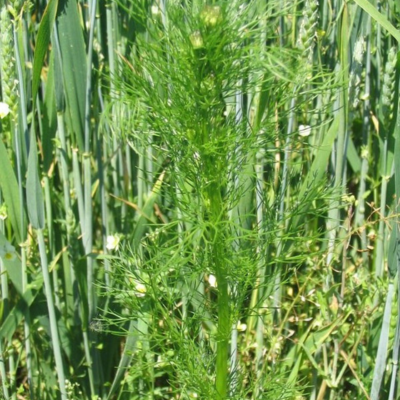Mayweed presence can have a significant impact on crop harvesting, moisture of the seed at harvesting and the level of admixture left in the harvested sample.
Mayweed presence can have a significant impact on crop harvesting, moisture of the seed at harvesting and the level of admixture left in the harvested sample.
Mayweeds are members of the Asteraceae (daisy) plant family. The species Matricaria spp. and Tripleurospermum spp. are common and high profile annual or hardy-annual composite weeds of superficially similar white daisy-like flowers. There are several widely distributed species including Scented Mayweed (Matricaria recutita), Scentless Mayweed (Tripleurospermum inodorum) and Pineappleweed (Matricaria matricarioides).

Mayweeds are dicotyledonous plants with narrow, finely divided and lobed
true leaves.
Scented Mayweed germinates all year, with particular flushes in spring and late summer to early autumn. It has a small seed that can only germinate from shallow depth and its prevalence may be favoured by minimum tillage cultivation systems. Characteristic flowers with yellow centres and white petals are normally seen in late spring and early summer. One plant can produce 5,000 seeds. It is usually found on light soils, but also occurs on heavy clays and loams.
Scentless Mayweed is the most widespread of mayweeds found on arable land and will germinate at most times of year. Peaks of germination are normally March and August to October. Germination of seed only occurs if they are near the soil surface. Flowering can occur from late spring through to autumn with each plant capable of producing up to 10,000 – 200,000 seeds. It is mainly a lowland species and prefers warm fertile and heavy soils.
The germination pattern of Pineappleweed is similar to that for Scented Mayweed but with the main flush being in spring. It appears to thrive in soil that is constantly disturbed and compacted, often being particularly prevalent in gateways and on field headlands. Plants flower in summer, without the characteristic white petals of other Mayweed species, and can produce 6,000 seeds per plant.
Mature plants are large, fleshy and robust and can be competitive with the crop. They germinate all year around and so affect both winter and spring sown crops Their presence can have a significant impact on crop harvesting, moisture of the seed at harvesting and the level of admixture left in the harvested sample. Seeds can survive for up to 5 years in the soil.
Whilst no resistance in the UK to florasulam or Arylex™ is reported by the Herbicide Resistance Action Committee (2024), it is appropriate when controlling mayweed to use products either in sequence or tank mixture that contain more than one mode of action.
Control in cereals crops can be achieved using products such as Zypar®, Spitfire® or Starane® XL. Shield Pro™ can also be used in cereal crops, providing a range of broad-leaved weed control and an alternative mode of action. All of these products can be used for control against species resistant to metsulfuron herbicides.
Zypar® is an herbicide for the control of broad-leaved weeds in winter cereals (wheat, durum wheat, spelt, barley, rye, triticale, oats) and spring cereals.
Spitfire® helps combat a wide range of broad-leaved weeds in cereal crops, for use in both autumn and spring.
Starane® XL controls cleavers and a range of other broad-leaved weeds in cereals.
